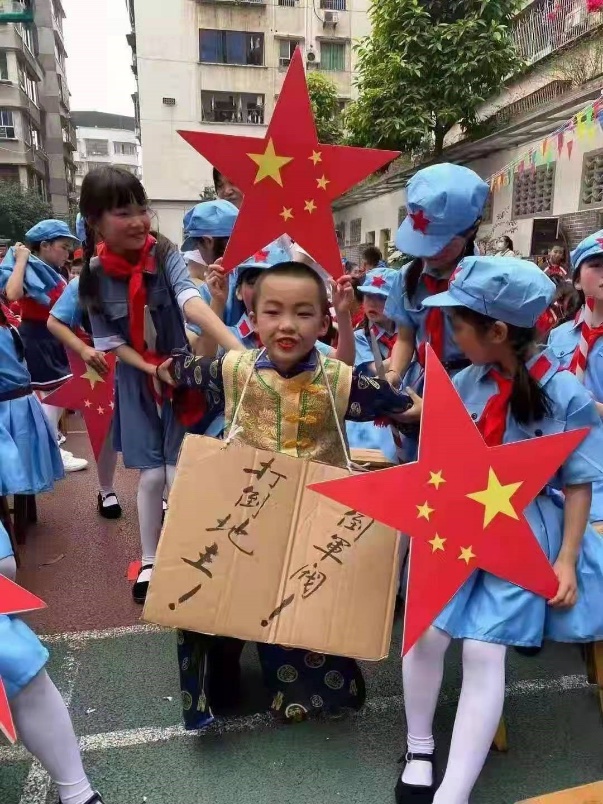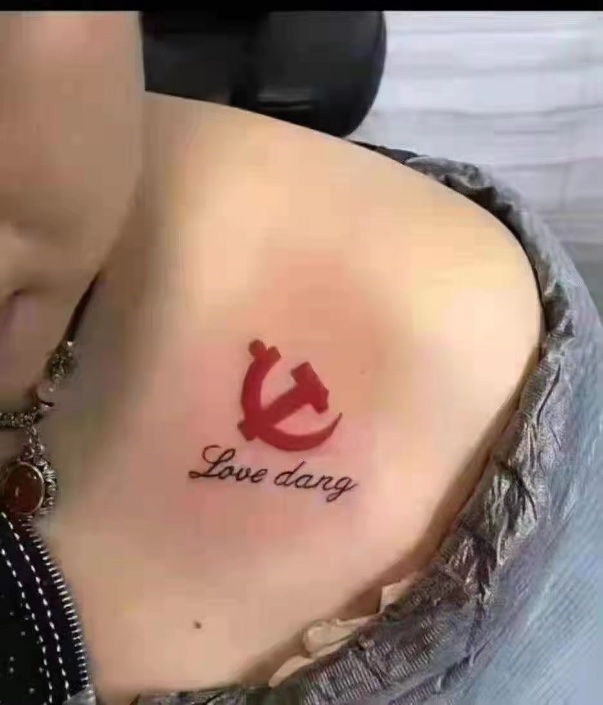Bringing back the Cultural Revolution — in English
« previous post | next post »
As part of the run-up to the celebration of the 100th anniversary of the Chinese Communist Party (CCP) that will take place in July, scenes like this are increasingly common on the streets of the PRC:
The sign on the cardboard placard hung from the neck of the little boy in this photograph reads:
Dǎdǎo dìzhǔ!
打倒地主!
"Down with landlords!"
Dǎdǎo jūnfá
打倒军阀!
"Down with warlords!"
It's interesting that the last word in the second slogan is written half in traditional script and half in simplified script: 軍閥 vs. 军阀.
Be that as it may, this is a scene that was common in the Red Guard struggle sessions during the Cultural Revolution (formally the Great Proletarian Cultural Revolution), the catastrophic communist convulsion that lasted from May 16, 1966 to October 6, 1976. For historical photographs showing such horrifying scenes that were prevalent during that horrifying decade, see this collection.
More striking than the above recreation is this current effusion of devotion to the CCP:
The "dang" tattooed on this young person's shoulder is not the English euphemistic exclamation, rather, it is Sinitic "dǎng 党 / 黨" ("party", as in "Chinese Communist Party").
You may wonder why they didn't just write "Love [the] Party". I have a number of hypotheses about why they wrote it the way they did, but am interested in hearing what Language Log readers think about the rationale for the wording as it appears in the photograph.
Before closing, I should note that all children in China begin intensive English instruction from elementary school, and many of them start to learn English already in kindergarten.
Selected readings
- "'Chinese light'" (7/12/18)
- "How English became such a dominant second language in China today" (11/8/15)
- "English in China" (10/25/06)
- "The Westernization of Chinese" (9/6/12)
- "'Have a good day!' in Mandarin" (9/5/12)
- "Creeping Romanization in Chinese" (8/30/12)
- "New radicals in an old writing system" (8/29/12)
[Photos from Alex Wang]


Nikita Kuzmin said,
May 28, 2021 @ 10:31 pm
I am very sad to see that photo… It reminded me about a video with Russian kindergarten kids wearing WW2 period army clothing, having toy guns , marching and imitating the Soviet soldiers https://tvrain.ru/news/s_sajta_pjatigorska_udalili_fotografiju_detej_s_avtomatami_na_parade_doshkolnyh_vojsk-485227/?utm_source=telegram&utm_medium=social&utm_campaign=news&utm_term=485227 (The text is in Russian, but you may have a look at the photo and the video). I would question the effectiveness of this way of "patriotic education", and think about the similarity of such propagandistic trends in Russia and China.
Michael Watts said,
May 29, 2021 @ 12:00 am
In terms of the syntax, 打倒地主 is a little more graphic/explicit than "down with landlords!". I might render it "strike down the landlords!".
It's possible and even likely that as used, it's basically just conventionalized in the manner of Iranian "death to America!".
alex said,
May 29, 2021 @ 10:29 am
The tattoo is interesting. In the west its hip to have Chinese character tattoos and for sure here many businesses have western names to come off as modern and advanced etc. I can see perhaps ironically it might be cooler to have English.
ouen said,
May 29, 2021 @ 2:14 pm
It just occurred to me that junfa written in pinyin looks very similar to junta, which is an interesting coincidence!
In Chinese it's increasingly common for younger generations to use the English word party in Chinese with the meaning of a get-together, a fun social event etc. The official way of writing the loanword is 派對 (pai4dui4), but lots of people i know will write 'party' even when the rest of the sentence is in Chinese. In oral Chinese those same people who write 'party' will often still pronounce it as 派對, which I find fascinating. For people who've been abroad it's a huge faux pas to use an English word but with local pronunciation, and as you can imagine lots of people find those people obnoxious. A bit like someone who has lived in France correcting an English monolglot on their pronunciation of croissant.
Michael Watts said,
May 29, 2021 @ 4:06 pm
Actually, yes, "Love dang" may just recognize that "love party" has an unfortunate primary meaning.
Jerry Packard said,
May 29, 2021 @ 4:23 pm
For what it's worth, it seems fairly obvious that the 'love dang' tattoo is photoshopped onto the person's arm in the photo, so the photo is not genuine.
alex wang said,
May 29, 2021 @ 5:12 pm
@Jerry Packard
"For what it's worth, it seems fairly obvious that the 'love dang' tattoo is photoshopped onto the person's arm in the photo, so the photo is not genuine."
I am the one who forwarded these. Many images such as the kids in costume and the tattoo circulate on wechat.
I can not be sure if the tattoo one is real. That said there is plenty of video that's too large to send other than by link of the growing party nationalism. I see it in the pubic school that is 2 blocks away. I see kids walking around in costume after rehearsing. I am sure I will be able to take some video as the celebration nears.
I will take the time to upload some videos which I don't believe are user created to youtube and provide a link.
As for the tattoo, do you think the image of the "hammer and sickle" and the "Love dang" were two separate items manipulated together or one unit placed on the person's upper chest.
With the advances in technology it is clear it is becoming harder to know as even deep fake videos proliferate.
As an aside how do you know if its a fake? I'm not a trained forensic in these matters and if the tattoo was a fake, I am sorry. It looks like the area on the skin still has the redness of a new tattoo that was almost healed and was showing it off. If it is fake there was no intent on my end to deceive.
Finally I forwarded it because I felt it was interesting. If it were a fake someone had to put the two parts (hammer and sickle and the Love dang) together. Personally I think they were one unit that someone created for perhaps a tattoo even if it were on someone else and photoshopped onto this person. I'm the first to admit I'm not a digital forensic expert.
Jerry Packard said,
May 29, 2021 @ 6:36 pm
Sorry. I'm just saying that the image has been photoshopped onto the person's arm. You can see the pixellation and format mismatch in the upper right hand corner where the 'tat' meets the skin, in addition to the pink vs. fleshtone color mismatch. As to whether "hammer and sickle" and the "Love dang" were two separate items, I don't know (though I do wonder…).
Jake said,
May 29, 2021 @ 7:16 pm
> in addition to the pink vs. fleshtone color mismatch
Isn't that just a normal 'fresh tattoo' reddening?
Seth said,
May 29, 2021 @ 7:40 pm
@Jerry Packard I think the pixellation is just a compression artifact. You can see the exact same effect on the upper left hand corner just above the nose. There's a marked blocky transition to the upper cheek. This was probably an extract from a lower-resolution bigger picture.
alex said,
May 29, 2021 @ 8:18 pm
@Jerry Packard
I didn't take any offense at all. Just wanted people to make sure that people know it was not an original photo by me and it could be a fake I wouldn't know. I just thought it was interesting they used the English and pinyin
Michael Watts said,
May 29, 2021 @ 8:45 pm
Before crying "photoshop" for the tattoo, I'd first think "this looks like it was taken on a phone". It doesn't look particularly unusual.
Jerry Packard said,
May 30, 2021 @ 8:00 am
It's pretty obvious.
John Swindle said,
May 30, 2021 @ 8:02 am
@Michael Watts: English-language publications from China in the Cultural Revolution era translated "打倒 …!" as "Down with …!" That gives the translation some historical resonance for those who followed the proceedings in English.
Ethan Glasser-Camp said,
May 30, 2021 @ 11:30 am
Nobody has commented on the unusual orientation of the hammer-and-sickle, which is 90 degrees clockwise of its typical. In other words, you would expect the words "love dang" to be between the handles, not alongside the sickle blade.
I think this "mistake" suggests that the tattoo is real and it reminds me of Hanzi Smatter.
alex said,
May 30, 2021 @ 9:06 pm
I had to google the term
http://hanzismatter.blogspot.com/
https://languagelog.ldc.upenn.edu/nll/?p=3160
John Swindle said,
May 30, 2021 @ 10:33 pm
Both things can be true: It can be a real photograph of a real body part with a real tattoo and also have been edited in one way or another.
Philip Taylor said,
May 31, 2021 @ 3:01 am
That was the opinion of a retired professional photographer whose views I sought, John — that the photograph was indeed "a real photograph of a real body part with a real tattoo" but had probably been tweaked in Adobe Photoshop He commented in particular on the saturation and uniformity of the red colouring in the hammer and sickle.
Victor Mair said,
May 31, 2021 @ 7:48 am
We have hundreds of PRC students at Penn. Most of them love to take photographs with their iPhones, and they're very good at it. One thing I've noticed is that they love to tweak and tinker with their photographs, especially the shots they admire the most. Because it's so easy to do with their sophisticated phones, once they identify a photograph they particularly like, they will enhance it till it reaches what they consider to be a stage of perfection. Such enhancement includes intensifying colors and adding background and shading.
I remember a photograph I took of Uyghur women in Khotan making bread. It was the best cell phone photograph I ever took (I took it with a borrowed phone; usually am very bad at it) — simply magnificent, evoking the atmosphere and spirit of the hot workplace scene. I showed it to one of my students, and the first thing she did, after recognizing my photograph as a great work of art, was start to "improve" it. I was crushed.